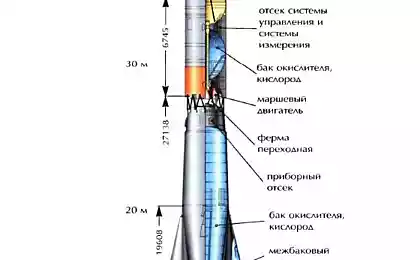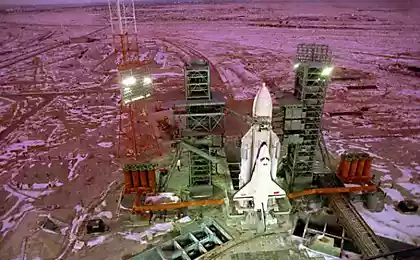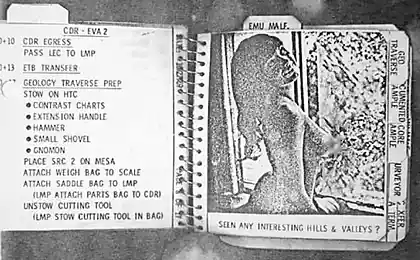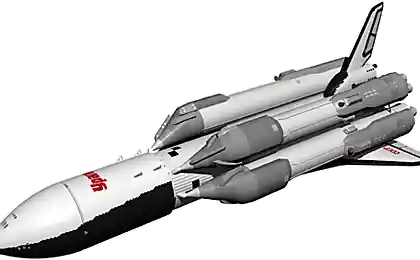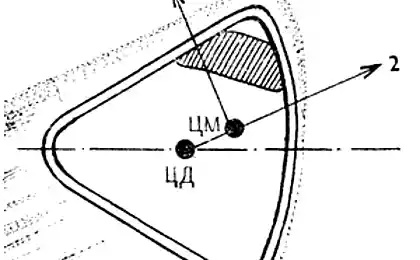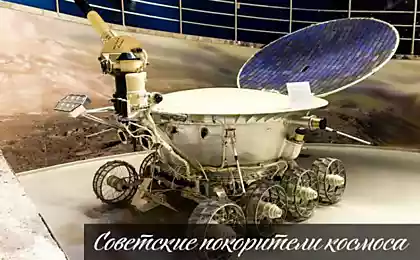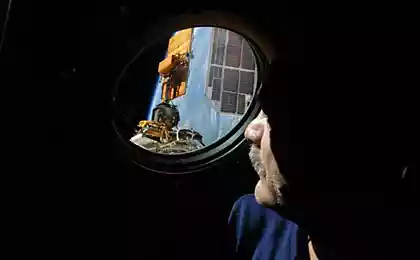1243
Space fountain
Recent years have marked the beginning of a new space race, but if in the 70s it was the race of the superpowers, but now it is a race of private companies. And the main problem of these companies is the conclusion of cargo into orbit. Used missiles are too expensive and can not afford to withdraw large amounts of cargo in a short time. Different projects have different solves this problem. But most of them are either not effective, or they do not possible to embody the present time. Among them wormed one, in my opinion the most promising and feasible today, the technology - Space fountain.
This concept was first presented jointly by Robert L. Forward, Marvin Minsky, John McCarthy, Hans Moravec, Roderick Hyde and Lowell Wood. An extensive amount of information about it can be found in Robert L. Forward «Indistinguishable From Magic».
Space fountain uses a continuous stream of electromagnetically accelerated metal pellets to deliver the goods at exorbitant heights, using the same basic physical principles, which usually keeps a plastic ball fountain upstairs vertical jet of water.
Small metal pellets million will be released to the station "deflector" high above the ground, which will use a magnetic field and catch the granules, blowing their curve electromagnetic accelerator and return them back to earth. The ground station, in turn, will use the magnetic "scoop" to catch the balls, let them curve back powerful electromagnetic accelerator to the station and all of this in one continuous loop. The pressure exerted on the magnetic field of a curved scoop and accelerator continuous flow of granules is maintained in the air the whole structure.
The key to understanding the cosmic fountain is that it uses a continuous stream of granules constantly puts pressure on the station and lift it up. Remember the analogy of the fountain, so it can keep the ball suspended from a water jet continuous recirculation of water: water that falls back into the fountain is sucked into the intakes and fed back into the water jet, and so on to infinity. Same with the metal "jet" cosmic fountain.
Furthermore, it is important to understand that the granules and the station will never have physical contact. Magnetic fields and curved scoop accelerator act as a kind of buffer, preventing any damage to the granules rushing to the station at a speed of 4 km / s. However, the granules have a pressure on the magnetic field passing through them, and this force is in turn transmitted to the station, holding it in the air.
Using this technology fountain could lift a fully equipped space station weighing 40 tons or more at any height, even at the height of the space elevator (40,000 km). However, the higher the altitude, the more energy is required (see below). To maintain the cosmic fountain about 2000 km in height requires a constant energy is comparable to the consumption of a modern city.
But one of the advantages of the fountain is that after the system is started, the energy required to maintain it will be much less than the energy to run it. The loss of momentum from the force of gravity when the flow of the granules takes off will be exactly balanced by the increasing momentum of gravity when the tide will fall to the ground station and the total momentum of the system never changes. Entropy dictates that a certain amount of energy will eventually be lost over time, but it can easily be offset by the subsidiary power stations producing a small part of the energy needed for the initial launch of the system. Thus, even if the power supply is interrupted, the fountain will function normally for a while. Hanging plants in height from 1,000 km it can take up to several hours.
Space fountain, in all probability, will be built with excess flow support. Forward in his book mentions at least three to six or eight fountains, each with its own independent power supply. A striker in the novel Starquake, alien Cheela built a hexagonal structure of six separate fountains. Each of which is raised towards the hexagonal deflector station.
Another advantage outer fountain that the system can be built from scratch. Ground station and the deflector station with their accelerators can be completely constructed on the ground and the station will be located on top of the ground station aligned with accelerators. Then the force flow of granules slowly but eventually raised to the station first few inches, then a few hundred meters and so kilometer after kilometer. The process can be stopped at any height from a few centimeters to several thousand meters, for an indefinite period, which allows you to perform the calibration, maintenance, new construction, etc.
The source of energy for maintaining the fountain may also be used to support lateral structures such as elevators, or wall along its length. Electromagnetic accelerators / retarders can be built vertically along the "stream" of granules, so the fountain can be slowly built on the strength of the pellets. Since sections of walls (and any internal structure) can keep themselves in the air stream flowing through the inner them, they will not experience congestion, as it would be for ordinary buildings in the hundreds or thousands of kilometers in height.
Thus Space fountain can be used to create a truly gigantic buildings and towers. And, unlike the space elevator, Space fountain requires no extremely expensive or non-existent at the moment of materials for construction. Modern alloys and composite materials are quite suitable for its construction.
The most obvious use for such a super-high structure, of course, be as rocket-free space launch. On the outer walls can be installed electromagnetic accelerators "shoots" loads into orbit. Fountain is about 40 km in height will be enough to launch passengers into orbit with less than 3g of acceleration, and the height of 100 km or higher can just throw the cargo directly into orbit without exceeding even 1g.
Tower fountain can also be used as an overinflated arcology, research institutions, industrial centers, etc. Fountain 100 kilometers high and 100 meters wide, will be about 7 and 85 cubic kilometers of volume. Designers and architects can use this space for anything. But opportunities and wider and roomy tower.
Forward suggests that cosmic fountains first to be built in the "small" scale, and first used in the construction of kilometer transceiver towers for radio and television. The technology can be extended to support supervysotnyh buildings, and then, finally, it's time for the present cosmic fountain.
Source: habrahabr.ru/post/235605/
This concept was first presented jointly by Robert L. Forward, Marvin Minsky, John McCarthy, Hans Moravec, Roderick Hyde and Lowell Wood. An extensive amount of information about it can be found in Robert L. Forward «Indistinguishable From Magic».
Space fountain uses a continuous stream of electromagnetically accelerated metal pellets to deliver the goods at exorbitant heights, using the same basic physical principles, which usually keeps a plastic ball fountain upstairs vertical jet of water.
Small metal pellets million will be released to the station "deflector" high above the ground, which will use a magnetic field and catch the granules, blowing their curve electromagnetic accelerator and return them back to earth. The ground station, in turn, will use the magnetic "scoop" to catch the balls, let them curve back powerful electromagnetic accelerator to the station and all of this in one continuous loop. The pressure exerted on the magnetic field of a curved scoop and accelerator continuous flow of granules is maintained in the air the whole structure.
The key to understanding the cosmic fountain is that it uses a continuous stream of granules constantly puts pressure on the station and lift it up. Remember the analogy of the fountain, so it can keep the ball suspended from a water jet continuous recirculation of water: water that falls back into the fountain is sucked into the intakes and fed back into the water jet, and so on to infinity. Same with the metal "jet" cosmic fountain.
Furthermore, it is important to understand that the granules and the station will never have physical contact. Magnetic fields and curved scoop accelerator act as a kind of buffer, preventing any damage to the granules rushing to the station at a speed of 4 km / s. However, the granules have a pressure on the magnetic field passing through them, and this force is in turn transmitted to the station, holding it in the air.
Using this technology fountain could lift a fully equipped space station weighing 40 tons or more at any height, even at the height of the space elevator (40,000 km). However, the higher the altitude, the more energy is required (see below). To maintain the cosmic fountain about 2000 km in height requires a constant energy is comparable to the consumption of a modern city.
But one of the advantages of the fountain is that after the system is started, the energy required to maintain it will be much less than the energy to run it. The loss of momentum from the force of gravity when the flow of the granules takes off will be exactly balanced by the increasing momentum of gravity when the tide will fall to the ground station and the total momentum of the system never changes. Entropy dictates that a certain amount of energy will eventually be lost over time, but it can easily be offset by the subsidiary power stations producing a small part of the energy needed for the initial launch of the system. Thus, even if the power supply is interrupted, the fountain will function normally for a while. Hanging plants in height from 1,000 km it can take up to several hours.
Space fountain, in all probability, will be built with excess flow support. Forward in his book mentions at least three to six or eight fountains, each with its own independent power supply. A striker in the novel Starquake, alien Cheela built a hexagonal structure of six separate fountains. Each of which is raised towards the hexagonal deflector station.
Another advantage outer fountain that the system can be built from scratch. Ground station and the deflector station with their accelerators can be completely constructed on the ground and the station will be located on top of the ground station aligned with accelerators. Then the force flow of granules slowly but eventually raised to the station first few inches, then a few hundred meters and so kilometer after kilometer. The process can be stopped at any height from a few centimeters to several thousand meters, for an indefinite period, which allows you to perform the calibration, maintenance, new construction, etc.
The source of energy for maintaining the fountain may also be used to support lateral structures such as elevators, or wall along its length. Electromagnetic accelerators / retarders can be built vertically along the "stream" of granules, so the fountain can be slowly built on the strength of the pellets. Since sections of walls (and any internal structure) can keep themselves in the air stream flowing through the inner them, they will not experience congestion, as it would be for ordinary buildings in the hundreds or thousands of kilometers in height.
Thus Space fountain can be used to create a truly gigantic buildings and towers. And, unlike the space elevator, Space fountain requires no extremely expensive or non-existent at the moment of materials for construction. Modern alloys and composite materials are quite suitable for its construction.
The most obvious use for such a super-high structure, of course, be as rocket-free space launch. On the outer walls can be installed electromagnetic accelerators "shoots" loads into orbit. Fountain is about 40 km in height will be enough to launch passengers into orbit with less than 3g of acceleration, and the height of 100 km or higher can just throw the cargo directly into orbit without exceeding even 1g.
Tower fountain can also be used as an overinflated arcology, research institutions, industrial centers, etc. Fountain 100 kilometers high and 100 meters wide, will be about 7 and 85 cubic kilometers of volume. Designers and architects can use this space for anything. But opportunities and wider and roomy tower.
Forward suggests that cosmic fountains first to be built in the "small" scale, and first used in the construction of kilometer transceiver towers for radio and television. The technology can be extended to support supervysotnyh buildings, and then, finally, it's time for the present cosmic fountain.
Source: habrahabr.ru/post/235605/
Is it possible to "break" the Internet?
The project on the "fight to the death" on Google receives a research center at the cost of 1, 5 billion USD



